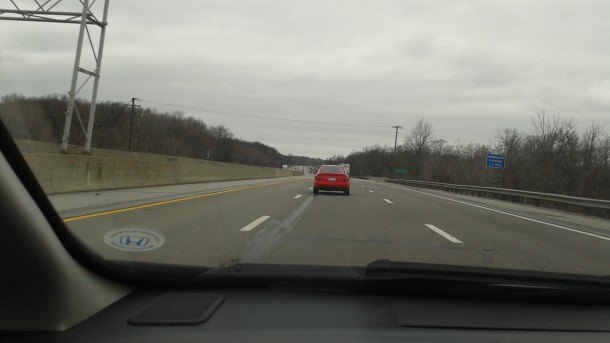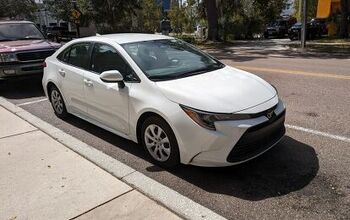The Fellowship of the Road

My father, may he rest in peace, grew up in Brooklyn, but met a Detroit girl while the U.S. Army Corps of Engineers sent him to the University of Michigan for a quickie associate degree in civil engineering during World War II. My sisters have both lived in the New York City area for decades. As a result, though I’m a native Detroiter and proud Michigander through-and-through, there’s probably never been a 12-month period in my life when I haven’t been in the Big Apple.
The construction of Interstate 80 was a great moment in our family’s life, as it meant taking at least two hours off of the Canadian route through Ontario and then down the New York State Thruway. It also meant finding out that people in Ohio take the Ohio State University versus the University of Michigan sports rivalry very seriously.
Ohio residents have their own horror stories about how police agencies in the state extract revenue from drivers, but if parking a car with Michigan plates in Ohio’s state capital poses a risk of vandalism, do you think a Ohio Highway Patrol trooper isn’t going to single out Michigan drivers for traffic enforcement?
You can do 80 miles per hour on most Michigan interstate highways without risking a ticket for exceeding the 70 mph legal limit on those roads. I’ve even had a Michigan State Police trooper apologize after pulling me over at 79. Ohio may be a crossroads state, but Michigan is a destination state. People come here to enjoy the Great Lakes, the Henry Ford Museum, golf courses in northern Michigan, and the Upper Peninsula. However, with the exception of Canadians on their way to Chicago, we don’t get a lot of traffic just passing through. Perhaps the Michigan State Police are a bit more hospitable than the Ohio Highway Patrol.
People in general drive slower, relative to the speed limits, on Ohio freeways than in Michigan. You can watch drivers slow down as they cross the state line. With Michigan plates on my car, I won’t risk doing more than 4 mph over the limit in Ohio. In places where the speed drops the speed to 60 or 55, which tend to be speed traps, I won’t go over the speed limit at all. Some of the foreign press cars I’ve driven have been plated in New Jersey. If I happen to take one of those south of the border, I might go a little bit faster.
If this is the case, how did I average about 80 mph in the stretch from Cleveland to Toledo when I returned to Detroit from the 2016 New York Auto Show in my own car? The answer to that question is the fellowship of the road.
After you’ve driven on the highway for a few years, you should have learned how to avoid tickets. Police are creatures of habit, too. I can’t say that I’ve ever seen an Ohio state trooper parked on the right side of the road on the part of I-80 that makes up the Ohio Turnpike. They invariably park on the crossovers in the median, perpendicular to the flow of traffic, often with a second trooper parked likewise just a couple of miles down the road. Consequently, you just might want to be over on the right, preferably with a truck masking you from radar, as you come over a rise.
You also learn how to spot rabbits — those folks who know how to smartly drive over the limit. They aren’t speeding in an extreme enough manner to attract attention, but they are going faster than the flow of traffic, making the most efficient trade-offs between getting there in a hurry and getting a ticket.
South of Cleveland, when a route notification lit up the nav app on my phone, I picked it up and ironically was distracted just enough to take the wrong fork. After a few turns, I re-entered I-80 immediately adjacent to the General Motors Lordstown assembly plant where the Chevy Cruze is built, 160 miles from my exit at Toledo.
Soon after I got on the interstate, doing my usual for Ohio 74 mph in the center lane, I was passed by a red Audi doing 79-81 in the left lane. It was a few years old but pristine. I wasn’t sure precisely what model it was because it had been debadged. Aha! A fellow enthusiast. Some drivers represent that they are car enthusiasts by putting Japanese or Korean domestic market badges on their Hondas and Kias. Others do it by debadging. The clean look is nice and it’s a lot better than putting a AMG badge from eBay on a Benz that had nothing to do with the volk in Affalterbach.
Texting a photo of the car to a friend who has an encyclopaedic knowledge of cars revealed it to be an A4, likely from the late 1990s. The red A4’s driver, a grey haired gentleman who looked to be about 55 years old, was keeping very good pace and he obviously knew what he was doing, so I fell in behind him and a Honda crossover did the same to me. The Audi driver and I started working together through traffic. Sometimes we’d both pass the same car in the middle lane at the same time, with one of us using the right lane and the other, the left. Other times, to keep our pace, we both balked semi drivers attempting the 61 mph vs 60 mph drag races that drivers of big trucks do to show that their time is more important than that of folks driving cars and light trucks.
While one driver who knows how to drive smart and fast can move quickly through traffic, two or three drivers doing the same and working together can travel even more efficiently, and likely with even less risk of a ticket. Doubling the human brainpower devoted to a problem can be an effective route to a solution. Of course, working together means you have to take a turn at the front of the paceline as well.
Mr. Red Audi was actually going a bit faster than my comfort zone, but a fellowship is a fellowship, so I took a couple of pulls myself.
We drove like that for about two hours, with no communication at all between us, save for messages sent by our driving. There was no flashing of headlights, looking at each other, or gestures of any kind. Except for the times we correctly anticipated speed traps, we kept at a pretty consistent 80 mph. When I told people back home in Michigan of going that fast in Ohio, they were astounded.
As I approached the exit to turn north onto I-75 at Toledo, it was clear that the Audi driver was continuing on I-80 since he was staying in the left lane. Traffic made it a little difficult but I was able to pull up abreast of him and give him a thumb’s up just before I turned off. He responded with a friendly wave of his right hand.
This isn’t the first time I’ve teamed up with other drivers to drive quickly on the interstates and I’m sure that many of you have done the same. Please share your experiences as members of the fellowship of the road in the comments.
Note: The conflict between Michigan and Ohio finds its origins long before that in college football. In the first half of the 19th century, the then territory of Michigan and state of Ohio actually came to arms over the location of the border between the two. When Michigan petitioned Congress to be a state in 1835, it wanted the border to be south of the recently established settlement of Toledo, then incorporated in Michigan’s Monroe County. Ohio wanted the line somewhat north of there. Militias were sent, shots were fired, but apparently no blood was shed. One is tempted to say that Michigan won the Toledo War because Ohio got stuck with Toledo and Michigan got the magnificent Upper Peninsula, which geographically should be in Wisconsin. However, in the 1830s, the Upper Peninsula was Indian territory, there were no treaties with those tribes, and nobody then knew of the peninsula’s wealth in copper and iron ore, or the way its lumber could be exploited. At the time, Michigan wasn’t happy with the deal but to join the Union it acquiesced. The Jeep factory in Toledo is an American treasure. But as a frequent visitor to the UP, I still think Michigan got the better deal.
[Images: © 2016 Ronnie Schreiber/The Truth About Cars]
Ronnie Schreiber edits Cars In Depth, a realistic perspective on cars & car culture and the original 3D car site. If you found this post worthwhile, you can get a parallax view at Cars In Depth. Thanks for reading – RJS

Ronnie Schreiber edits Cars In Depth, the original 3D car site.
More by Ronnie Schreiber
Latest Car Reviews
Read moreLatest Product Reviews
Read moreRecent Comments
- FreedMike I'd say that question is up to the southern auto workers. If I were in their shoes, I probably wouldn't if the wages/benefits were at at some kind of parity with unionized shops. But let's be clear here: the only thing keeping those wages/benefits at par IS the threat of unionization.
- 1995 SC So if they vote it down, the UAW gets to keep trying. Is there a means for a UAW factory to decide they no longer wish to be represented and vote the union out?
- Lorenzo The Longshoreman/philosopher Eri Hoffer postulated "Every great cause begins as a movement, becomes a business, and ends up as a racket." That pretty much describes the progression of the United Auto Workers since World War II, so if THEY are the union, the answer is 'no'.
- Redapple2 I think I ve been in 100 plants. ~ 20 in Mexico. ~10 Europe. Balance usa. About 1/2 nonunion. I supervised UAW skilled trades guys at GM Powertrain for 6 years. I know the answer.PS- you do know GM products - sales weighted - average about 40% USA-Canada Content.
- Jrhurren Unions and ownership need to work towards the common good together. Shawn Fain is a clown who would love to drive the companies out of business (or offshored) just to claim victory.



































Comments
Join the conversation
It really is different in Ohio now that the rural speed limits are 70mph, keep it within ten of the limit and you are good to go.
"Volk". Nouns are capitalized in German